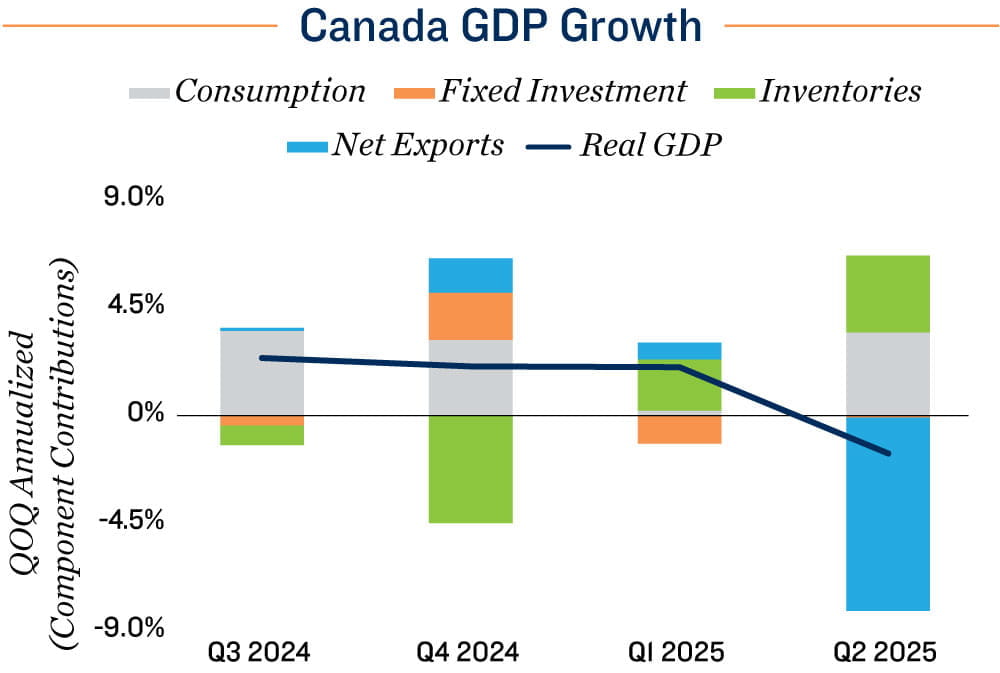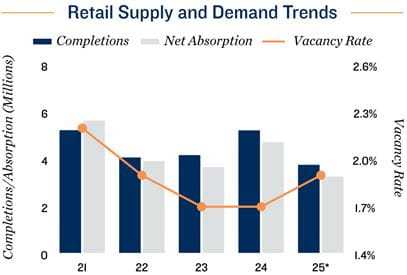Research Brief
Canada GDP
September 2025

Weak Growth to Spur Easier Policy, Setting the
Stage for Investment Recovery
GDP contracted as exports and investment fell. Canada’s economy shrank by 1.6 per cent in the April-June period on a quarter-over-quarter annualized basis – well below the market consensus of a 0.7 per cent decline. This outsized loss was driven by a sharp drop in exports following tariff front-running earlier in the year, alongside continued weakness in business fixed investment. At the same time, manufacturers and wholesalers built up inventories amid trade policy uncertainties, partially offsetting the external drag on GDP growth. Another bright spot was household consumption, which rose 4.5 per cent, boosted in part by a surge in auto sales early in the quarter. Government consumption and investment also climbed 5.7 per cent, providing an additional backstop and helping to support final domestic demand in the second quarter
Weak growth outlook to facilitate rate cuts. While headline growth missed market expectations, it was broadly consistent with the Bank of Canada’s projection of a 1.5 per cent contraction. Nevertheless, the sluggish 0.1 per cent advance estimate for July GDP points to a less optimistic outlook than the Bank’s forecast, which projected a 1.0 per cent expansion for the third quarter. With Canada having recently dropped tariffs on USMCA-compliant U.S. imports, concerns over near-term inflationary pressures should ease, giving the Bank more room to adjust policy so it can address downside growth risks. As such, the Bank may resume interest rate cuts over the remainder of 2025, bringing the overnight rate closer to 2.0 per cent.
Commercial Real Estate Outlook
Consumer resilience upholds retail fundamentals. After a muted 0.5 per cent rise in the first quarter, household consumption growth rebounded to 4.5 per cent in the second quarter. This momentum, aided by a drawdown of household savings amid slower income growth, stood in stark contrast to weak consumer sentiment that signaled reduced spending intentions. Over the past two years, the household savings rate rose from 3.7 per cent in 2023 to 6.0 per cent last year. Although the measure edged down to 5.0 per cent in the second quarter, it remains elevated by historical standards. This suggests households may still have capacity to sustain spending in the near term – especially as the BoC is expected to cut interest rates further through year-end. Canada’s retail sector is therefore likely to remain robust, with resilient consumer spending supporting leasing demand. Amid muted construction activity, vacancy rates are projected to stay low, despite a slight increase earlier this year.
Investment activity set to recover. Over the second half of the year, borrowing conditions could become more accommodative. In Canada, the BoC may resume rate cuts amid weaker growth and easing inflationary pressures. Meanwhile, the U.S. Federal Reserve could also adopt a more dovish stance following signs of weakening in the U.S. labour market. If these expectations materialize, long-term yields could decline – a key driver for investment activity. Commercial property sales in Canada may regain momentum as a result, aided by lower financing costs and renewed investor confidence.


* Forecast
Sources: Marcus & Millichap Research Services; CoStar Group, Inc.; Statistics Canada
TO READ THE FULL ARTICLE

